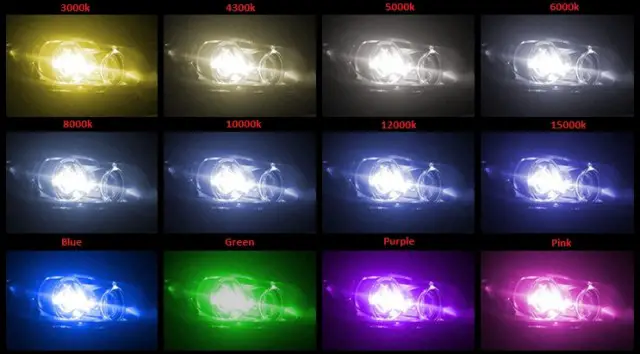Contents
Headlights in cars improved lately to a point where night driving becomes almost as easy as driving through the day. One of the main reasons why headlights today are so good is replacing the old halogen bulbs with newer technologies.
The first that made the jump was HID (High-Intensity Discharge) technology, also known as xenon lights. This technology greatly improved on halogen bulbs, both on light intensity and energy consumption.
HID or xenon lights were first introduced to the general public in 1991 with the launch of the then-new BMW 7-Series. Almost instantly, other luxury automakers followed suit and replaced the halogen bulbs in their cars with HID bulbs.
That said, while these headlights were available as an option on cheaper cars, they were never offered as standard. The reason behind this is simple – HID bulbs are much more expensive than normal halogen bulbs.
Still, many people value the properties of HID bulbs enough to pay the price. And in all honesty, HID headlights can improve on visibility greatly, which in turn also improves safety. They are also more durable – the best hid headlights last for over ten years.
So, xenon headlights are certainly the way to go, but are there differences between various HID bulbs? You bet! Xenon bulbs differ in the light intensity produced (in Lumens), the power they consume (in Watts), and the temperature of light they produce (in Kelvins).
The Lumens and Watts are pretty self-explanatory and are usually there so that you’re sure the bulbs will fit your car. The xenon headlights color temperature, on the other hand, depends on your needs and wishes. Here we’re going to help you choose the right HID color temperature for your car.
How HID bulbs work?
While halogen lights produce light with the help of a tungsten filament, HID bulbs use noble gasses, such as xenon. Xenon lights up when electricity is introduced via an electric arc between two electrodes inside the bulb. Naturally, these bulbs are much cooler than halogen bulbs, which convert most of the electricity into heat. That’s why HID bulbs are more efficient and produce more intense light.
HID Color & Temperature Chart

Understanding Xenon color temperature scale
The temperature of the light literally tells you how “warm” or “cold” the light output is. Humans perceive red and yellow as warmer colors, and white, blue, and purple as colder colors. That said, the HID color temperature is not only about how you feel but also about how much you can see on the road.
Let us explain things with nature, shall we? At sunset, the sun produces very warm light. This gives the colors a more saturated appearance, but also reduces the overall contrast and perceived sharpness of the scene. When the sun is on the horizon, on the other hand, the color temperature is much cooler, and the contrast and perceived sharpness rise. In other words, you’re likely to see things in the distant better when the sun is on the horizon than at sunset.
It’s the same with headlight bulbs – colder colors give you more contrast. However, warmer colors have other advantages, like in a fog, for example. Warmer light can more easily cut through the fog and illuminate the road, while colder colors will illuminate the fog itself. Let’s have a more detailed look in the next section.
Breaking down HID color temperatures

Golden yellow light (3000K)
This is the warmest xenon headlights color temperature that you can find (even though there are warmer temperatures on the HID color chart). It’s the same color temperature of older models of halogen bulbs and is great for driving through fog. However, 3000K HID’s aren’t the best choice for night driving. The reason is simple – the scene will look less sharp and contrasty. However, golden yellow light might be great for fog lights, which can be used in cases of fog.
Yellow-white (4300K)
Yellow-white or 4300K HID’s produce much more natural temperature output, closer to daylight. With a set of 4300K bulbs upfront, you will have balanced headlights for both night driving and fog. However, this color temperature is still far from the best for night driving, which is what headlights are made for.
Bright white (5000K)
This is the most popular xenon headlight color temperature. As you can see from the HID color chart above, 5000K HID bulbs are situated right between the yellow and blue end of the spectrum. They most closely resemble daylight when the sun is on the horizon. With a set of these bulbs, the night scene will appear sharper, and it will be easier to see things in the distance.
Alpine White (6000K)
6000K HID bulbs have a “whiter” output to 5000K bulbs, which some people prefer. During the night, it will be hard to notice the difference between both of them, but the Alpine white should additionally improve the contrast on the scene during the night. However, these bulbs have poor visibility during foggy days or nights. Consider complementing them with warmer fog lights.
Ice blue (8000K)
Blue headlights bulbs, such as the “Ice blue” 8000K option, are mostly used for cosmetic purposes. They look much “cooler,” literally, and make cars appear more modern. However, even though this color temperature is still useful, it can cause eyestrain during the night. Also, the light output falls considerably.
Pure blue (10000K)
Pure blue lights don’t offer any significant advantages, other than the fact that they look cool and refreshing.
Purple (12000K)
Purple HID headlight bulbs are by far the worse choice for driving and can cause severe eye strain. However, if you want your car to look stylish, purple bulbs might be the best choice out there.
Blue & Purple HID Headlights (pros & cons)
Pros of blue & purple HID headlights
- Stylish appearance: we think that everybody can agree on this – blue headlights look stunning. Your car will immediately have more luxurious and sportier.
Cons of blue & purple HID headlights
- Cause eyestrain: blue light is not found in nature, and our eyes aren’t designed for it. That’s why prolonged looking at blue light can cause eyestrain and other issues with human sight.
- Bad for incoming traffic: looking at blue lights head-on is even worse, and it can severely limit the view of cars incoming towards you.
- Illegal in some countries: check before installing blue lights on your car as they might be illegal in your area.
- Useless in fog: you might be better off driving without the headlights on altogether.
What is the brightest HID color temperature?
Bright white HID bulbs (5000K) produce the brightest light output. However, both yellow-white (4300K) and alpine white (6000K) are very close in the light output, and the difference is often negligible.
What color temperature HID is best?
It is generally considered that 5000K is the best xenon headlights color temperature thanks to the brightest output and similarity to daylight. It also sits in the middle of the HID color chart, which means that it’s the best of both worlds.
What is the best HID color temperature for fog lights?
Warmer temperature light is much better for hazy weather, such as fog, rain, and snow. That’s why we recommend going for 3000K bulbs for your fog lights.

Headlights are automotive jewelry. Correct fitment coupled with the right choice of technology will turn your vehicle into a shining gem.
Official sources of fitment information – https://sylvania-automotive.com and https://www.automotivebulbfinder.com/philips/